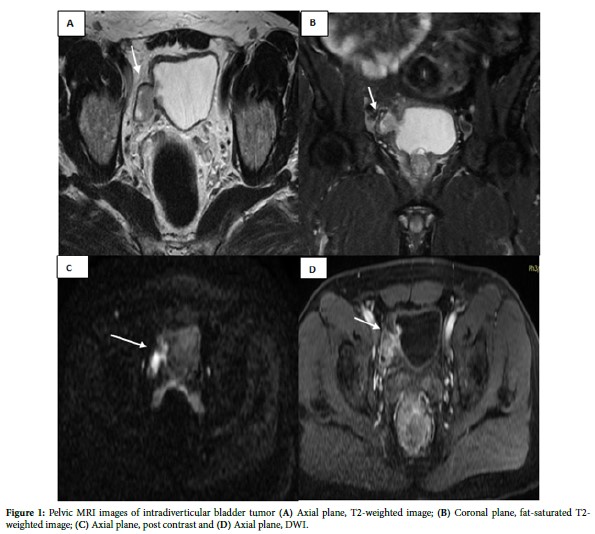2376-0249
Clinical-Medical Image - International Journal of Clinical & Medical Images (2023) Volume 10, Issue 8

Author(s): Boujida Nadia*, Boui Meriem, Koudouhonon Rita Oze, Lahkim Mohamed, Saouab Rachida and El Fenni Jamal
Department of Radiology, Mohammed Vth Military Hospital, Ryad Street, 10010 Rabat, Morocco
Received: 02 August 2023, Manuscript No. ijcmi-23-108924; Editor assigned: 03 August 2023, Pre QC No. P-108924; Reviewed: 07 August 2023, QC No. Q-108924; Revised: 09 August 2023, Manuscript No. R-108924; Published: 16 August 2023, DOI:10.4172/2376-0249.1000906
Citation: Nadia B, Meriem B, Oze KR, Mohamed L and Rachida S, et al. (2023) A Rare yet Classic Case: Intradiverticular Bladder Tumors. Int J Clin Med Imaging 10: 906.
Copyright: © 2023 Nadia B, et al. This is an open-access article distributed under the terms of the Creative Commons Attribution License, which permits unrestricted use, distribution and reproduction in any medium, provided the original author and source are credited.
A 68-year-old male, presented with intermittent gross hematuria and irritative lower urinary tract symptoms over the past six months. A pelvic MRI revealed a right latero-vesical diverticulum measuring 26 mm in transverse diameter, with a narrow neck measuring 9 mm. Within this diverticulum, there was a budding tissular process showing intermediate signal intensity on T2-weighted images, along with restricted diffusion and enhancement after gadolinium injection. The budding tissular process measured 28 mm in transverse diameter and extended into the bladder through its neck. Intradiverticular bladder tumors are relatively rare, accounting for approximately 1.5% of all bladder tumors [1]. These tumors develop within the bladder diverticula, which result from increased intravesical pressure, causing outpouching of the bladder urothelium through the muscularis propria [2]. The most common histological type of intradiverticular bladder tumors is urothelial carcinoma [2]. There is increasing evidence suggesting that the stasis of urine in the bladder diverticulum leads to chronic mucosal irritation and prolonged exposure to urinary carcinogens. Consequently, this heightened exposure to carcinogens increases the risk of malignancies developing within the diverticulum’s epithelial lining [3]. Neoplasms that develop within a bladder diverticulum present unique challenges concerning diagnosis and treatment. The most common clinical symptom is painless gross hematuria. The diagnostic modalities used are similar to those for bladder cancer, including urine cytology, cystoscopy and radiologic examinations such as IVP (Intravenous Pyelogram), computed tomography and magnetic resonance imaging. These tests are valuable tools in diagnosing bladder diverticular cancer [4]. Bladder diverticulum neoplasms have a poor prognosis because the diagnosis is late and associated with early invasion, which results from the anatomy of the diverticulum that lack muscular fibers [3]. The surgical treatment options for bladder diverticulum neoplasms range from conservative transurethral resection to more aggressive radical cystectomy. Within Transurethral Resection of the Tumor (TURBT), achieving complete resection can be challenging and there is a higher risk of tumor recurrence compared to non-diverticular tumors. In certain cases, when the tumor is extensive or recurrent, partial cystectomy emerges as a viable alternative for the treatment of bladder diverticular cancer. With the advancements in minimal invasive surgery, laparoscopic diverticulectomy or partial cystectomy has shown promising results [4]. Due to the rarity of intradiverticular bladder tumors, large-scale clinical trials specifically addressing this entity are limited. As a result, treatment decisions are frequently made based on expert consensus and individual patient factors.
Intradiverticular bladder tumors; Bladder diverticulum; MRI
None of the authors have any conflict of interest to disclose.
[1] Amer ML, Mumtaz H, Russell B, Gan J and Rehman Z, et al. (2022). Intra-diverticular bladder tumours: How to manage rationally. J Urol 3: 303-313.
[2] Poletajew S, Krajewski W, Adamowicz J, Kołodziej A and Zdrojowy R, et al. (2020). Management of intradiverticular bladder tumours: A systematic review. Urol Int 104: 42-47.
Google Scholar, Crossref, Indexed at
[3] Al-Hajjaj M. (2021). High-grade intradiverticulum bladder tumor: A case report. Int J Surg Case Rep 83.
Google Scholar, Crossref, Indexed at
[4] Chen HE, Lin YC and Cheng YH. (2016). Urothelial carcinoma arising within bladder diverticulum—Report of a case and review of the literature. Urol Sci 27: 177-180.
 Awards Nomination
Awards Nomination

